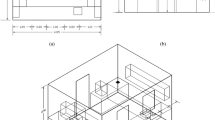Abstract
High volatile organic compound (VOC) concentrations following building decoration have been observed frequently. In reality, however, residents do not know the indoor VOC concentration levels until the buildings are tested, which seldom provides a preventive measure. While several indoor air quality (IAQ) simulation programs have been developed to predict indoor contaminant levels, case studies in the literature are scarce regarding the predictability of indoor VOC concentrations as well as how such predictions could be performed in real buildings. In this paper, we intended to conduct a proof-of-concept study whether simulations can help to reveal some of the key features of VOC concentrations during indoor decoration process. We conducted a case study, simulated and measured the VOC concentrations of a residential unit during the room decoration process. Results show that while certain agreement was achieved between the measurement and simulation, application of IAQ models to real buildings is challenging under the best of circumstances—single zone spaces with very few emission materials inside.
Similar content being viewed by others
References
ACGIH (2003). Documentation of the TLVs and BEIs with Other Worldwide Occupational Exposure Values. Cincinnati, USA: American Conference of Governmental Industrial Hygienists.
ASTM (1990). Standard Guide for Small-scale Environmental Chamber Determinations of Organic Emissions from Indoor Materials/products, ASTM, D5116. Philadelphia, USA: American Society for Testing and Materials.
Brohus H (1997). Personal exposure to contaminant sources in ventilated rooms. PhD Thesis, Department of Building Technology and Structural Engineering, Aalborg University, Denmark.
Chao CYH, Tung TC (2001). An empirical model for outdoor contaminant transmission into residential buildings and experimental verification. Atmospheric Environment, 35: 1585–1596.
De Bellie L, Haghighat F, Zhang Y (1995). Review of the effect of environmental parameters on material emissions. In: Proceedings of 2nd International Conference on Indoor Air Quality, Ventilation, and Energy conservation in Buildings (pp. 111–119), Montreal, Canada.
Deng Q, Yang X, Zhang JS (2012). Key factor analysis of VOC sorption and its impact on indoor concentrations: The role of ventilation. Building and Environment, 47: 182–187.
Gao C, Lee WL (2011). Evaluating the influence of openings configuration on natural ventilation performance of residential units in Hong Kong. Building and Environment, 46: 961–969.
GB/T 18883 (2002). Indoor Air Quality Standard of China. (in Chinese)
Ghiaus C, Allard F, Santamouris M, Georgakis C, Nicol F (2006). Urban environment influence on natural ventilation potential. Building and Environment, 41: 395–406.
Haghighat F, Donnini G (1993). Emissions of indoor pollutants from building materials—state of the art review. Architectural Science Review, 36: 13–22.
Haghighat F, Jiang Z, Zhang Y (1994). The impact of ventilation rate and partition layout on the VOC emission rate: time-dependent contaminant removal. Indoor Air, 4: 276–283.
He G, Yang X (2005). On regression method to obtain emission parameters of building materials. Building and Environment, 40: 1282–1287.
Li F, Niu J (2005). Simultaneous estimation of VOCs diffusion and partition coefficients in building materials via inverse analysis. Building and Environment, 40: 1366–1374.
Molhave L, Krzyzanowski M (2003). The right to healthy indoor air: status by 2002. Indoor Air, 13: 50–53.
OSHA (2004). Air Contaminants, Code of Federal Regulations, Title 29, Part 1910.1000. Occupational Safety and Health Administration.
Pei J, Zhang JS (2010). Modeling of sorbent-based gas filters: Development, verification and experimental validation. Building Simulation, 3: 75–86.
Roetzel A, Tsangrassoulis A, Dietrich U, Busching S (2010). A review of occupant control on natural ventilation. Renewable and Sustainable Energy Reviews, 14: 1001–1013.
Saijo Y, Kishi R, Sata R, Katakura Y, Urashima Y, Hatakeyama A, Kobayashi A, Jin K, Kurahashi N, Kondo T, Gong YY, Umemura T (2004). Symptoms in relation to chemicals and dampness in newly built dwellings. International Archives of Occupational and Environmental Health, 77: 461–470.
Sakaguchi J, Akabayashi S (2003). Field survey of indoor air quality in detached houses in Niigata Prefecture. Indoor Air, 13: 42–49.
Sherman MH (1990). Tracer-Gas techniques for measuring ventilation in a single zone. Building and Environment, 25: 365–374.
Tichenor BA, Guo Z, Dunn JE, Sparks LE (1991). The interaction of vapour phase organic compounds with indoor sinks. Indoor Air, 1: 23–25.
Walton GN, Dols WS (2010). CONTAMW 3.0 user manual. Gaithersburg, MD, USA, National Institute of Standards and Technology.
Wang C, Zhang H, Jiang R, Jiang Q, Song W (2005). Study on the indoor air levels of indoor formaldehyde and total volatile organic compounds after decoration. Journal of Environment and Health, 22: 356–358. (in Chinese)
Wang L, Emmerich S (2010). Modeling the effects of outdoor gasoline powered generator use on indoor carbon monoxide exposures. Building Simulation, 3: 39–50.
Won D, Sander DM, Shaw CY, Corsi RL (2001). Validation of the surface sink model for sorptive interactions between VOCs and indoor materials. Atmospheric Environment, 35: 4479–4488.
Yang X (1999). Study of building material emissions and indoor air quality. PhD Dissertation, Department of Architecture, Massachusetts Institute of Technology, USA.
Yang X, Chen Q (2001). A coupled airflow and source/sink model for simulating indoor VOC exposures. Indoor Air, 11: 257–269.
Zhang JS (2005). Combined heat, air, moisture, and pollutants transport in building environmental systems. JSME International Journal Series B, 48: 182–190.
Author information
Authors and Affiliations
Corresponding author
Rights and permissions
About this article
Cite this article
Liang, W., Gao, P., Guan, J. et al. Modeling volatile organic compound (VOC) concentrations due to material emissions in a real residential unit. Part I: Methodology and a preliminary case study. Build. Simul. 5, 351–357 (2012). https://doi.org/10.1007/s12273-012-0083-6
Received:
Revised:
Accepted:
Published:
Issue Date:
DOI: https://doi.org/10.1007/s12273-012-0083-6




